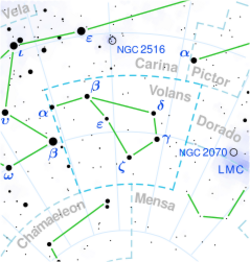Astronomy:HD 70514
| Observation data Epoch J2000.0 Equinox (celestial coordinates) | |
|---|---|
| Constellation | Volans |
| Right ascension | 08h 18m 18.80687s[1] |
| Declination | −65° 36′ 47.4919″[1] |
| Apparent magnitude (V) | 5.06±0.01[2] |
| Characteristics | |
| Evolutionary stage | RGB[3] |
| Spectral type | K1 III[4] |
| U−B color index | +1.19[5] |
| B−V color index | +1.15[5] |
| Astrometry | |
| Radial velocity (Rv) | 0.00±1.78[6] km/s |
| Proper motion (μ) | RA: +21.054[1] mas/yr Dec.: +21.799[1] mas/yr |
| Parallax (π) | 10.9324 ± 0.0626[1] mas |
| Distance | 298 ± 2 ly (91.5 ± 0.5 pc) |
| Absolute magnitude (MV) | +0.26[7] |
| Details | |
| Mass | 1.88±0.29[3] M☉ |
| Radius | 14.6[8] R☉ |
| Luminosity | 93±1[1] L☉ |
| Surface gravity (log g) | 2.27±0.47[9] cgs |
| Temperature | 4,610±90[10] K |
| Metallicity [Fe/H] | +0.22[11] dex |
| Rotational velocity (v sin i) | <1[12] km/s |
| Other designations | |
| Database references | |
| SIMBAD | data |
HD 70514, also known as HR 3280, is a solitary,[13] orange hued star located in the southern circumpolar constellation Volans, the flying fish. It has an apparent magnitude of 5.06,[2] making it one of the brighter members of this generally faint constellation. Based on parallax measurements from the Gaia spacecraft, the star is estimated to be 298 light years distant.[1] It appears that its distance to the Solar System isn't changing, having a heliocentric radial velocity of 0 km/s.[6] Eggen (1994) lists it as a member of the thin disk population.[11]
HD 70514 is classified as a red giant, having a stellar classification of K1 III. It is currently on the red giant branch, fusing a hydrogen shell around an inert helium. As a result, it has expanded to 14.6 times radius of the Sun[8] and now radiates 93 times its luminosity[1] from its enlarged photosphere at an effective temperature of 4,610 K.[10] Based on asteroseismologic measurements, HD 70514 has a mass 1.88 times that of the Sun.[3] HR 3280 is metal enriched, having a metallicity 66% above solar levels. Like most giants, it rotates rather slowly, having a projected rotational velocity of <1 km/s.[12]
References
- ↑ 1.0 1.1 1.2 1.3 1.4 1.5 1.6 1.7 Vallenari, A. et al. (2022). "Gaia Data Release 3. Summary of the content and survey properties". Astronomy & Astrophysics. doi:10.1051/0004-6361/202243940 Gaia DR3 record for this source at VizieR.
- ↑ 2.0 2.1 Høg, E.; Fabricius, C.; Makarov, V. V.; Urban, S.; Corbin, T.; Wycoff, G.; Bastian, U.; Schwekendiek, P. et al. (March 2000). "The Tycho-2 catalogue of the 2.5 million brightest stars". Astronomy and Astrophysics 355: L27–L30. ISSN 0004-6361. Bibcode: 2000A&A...355L..27H.
- ↑ 3.0 3.1 3.2 Stello, D.; Bruntt, H.; Preston, H.; Buzasi, D. (15 January 2008). "Oscillating K Giants with the WIRESatellite: Determination of Their Asteroseismic Masses". The Astrophysical Journal 674 (1): L53–L56. doi:10.1086/528936. ISSN 0004-637X. Bibcode: 2008ApJ...674L..53S.
- ↑ Houk, N.; Cowley, A. P. (1975). University of Michigan Catalogue of two-dimensional spectral types for the HD stars. Volume I. Declinations −90° to −53°. Bibcode: 1975mcts.book.....H.
- ↑ 5.0 5.1 Johnson, H. L.; Mitchell, R. I.; Iriarte, B.; Wisniewski, W. Z. (1966). "UBVRIJKL Photometry of the Bright Stars". Communications of the Lunar and Planetary Laboratory 4: 99–110. Bibcode: 1966CoLPL...4...99J.
- ↑ 6.0 6.1 Kharchenko, N.V.; Scholz, R.-D.; Piskunov, A.E.; Röser, S.; Schilbach, E. (November 2007). "Astrophysical supplements to the ASCC-2.5: Ia. Radial velocities of ~55000 stars and mean radial velocities of 516 Galactic open clusters and associations". Astronomische Nachrichten 328 (9): 889–896. doi:10.1002/asna.200710776. ISSN 0004-6337. Bibcode: 2007AN....328..889K.
- ↑ Anderson, E.; Francis, Ch. (May 2012). "XHIP: An extended hipparcos compilation". Astronomy Letters 38 (5): 331–346. doi:10.1134/S1063773712050015. ISSN 1063-7737. Bibcode: 2012AstL...38..331A.
- ↑ 8.0 8.1 Stassun, Keivan G. et al. (9 September 2019). "The Revised TESS Input Catalog and Candidate Target List". The Astronomical Journal 158 (4): 138. doi:10.3847/1538-3881/ab3467. Bibcode: 2019AJ....158..138S.
- ↑ Allende Prieto, C.; Lambert, D. L. (December 1999). "Fundamental parameters of nearby stars from the comparison with evolutionary calculations: masses, radii and effective temperatures". Astronomy and Astrophysics 352: 555–562. ISSN 0004-6361. Bibcode: 1999A&A...352..555A.
- ↑ 10.0 10.1 Charbonnel, C.; Lagarde, N.; Jasniewicz, G.; North, P. L.; Shetrone, M.; Krugler Hollek, J.; Smith, V. V.; Smiljanic, R. et al. (January 2020). "Lithium in red giant stars: Constraining non-standard mixing with large surveys in the Gaia era". Astronomy & Astrophysics 633: A34. doi:10.1051/0004-6361/201936360. ISSN 0004-6361. Bibcode: 2020A&A...633A..34C.
- ↑ 11.0 11.1 Eggen, O. J. (February 1994). "Evolved GK stars near the Sun. 2: The young disk population". The Astronomical Journal 107: 594. doi:10.1086/116879. ISSN 0004-6256. Bibcode: 1994AJ....107..594E.
- ↑ 12.0 12.1 De Medeiros, J. R.; Alves, S.; Udry, S.; Andersen, J.; Nordström, B.; Mayor, M. (2014-01-01). "A catalog of rotational and radial velocities for evolved stars. V. Southern stars". Astronomy and Astrophysics 561: A126. doi:10.1051/0004-6361/201220762. ISSN 0004-6361. Bibcode: 2014A&A...561A.126D.
- ↑ Eggleton, P. P.; Tokovinin, A. A. (11 September 2008). "A catalogue of multiplicity among bright stellar systems". Monthly Notices of the Royal Astronomical Society 389 (2): 869–879. doi:10.1111/j.1365-2966.2008.13596.x. ISSN 0035-8711. Bibcode: 2008MNRAS.389..869E.
<ref> tag with name "Gould1879" defined in <references> is not used in prior text.
 |


